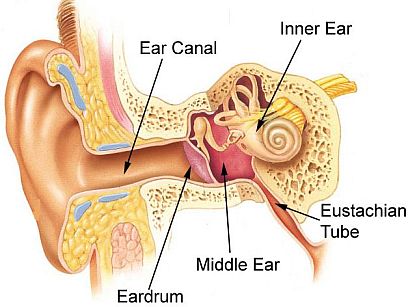Ear Congestion – Causes and Treatment for Congested Ears
To understand the causes of ear congestion you need to first know that the ear includes three parts: middle, inner and external. The middle ear transfers vibrations to the inner ear (the part of the ear that aids in hearing sounds). The Eustachian tube, a narrow tube that connects the middle ear to the adenoidal (nasal) opening, helps regulate the pressure between the middle ear and external ear. Ear congestion typically occurs when the Eustachian tube, located between the ear and throat, becomes blocked.

A variety of medical conditions (allergies, viruses, colds and upper respiratory infections) can cause fluid to collect in the Eustachian tube and/or middle ear, leading to congested ears. Ear congestion symptoms may include: muffled hearing, pain, inflammation, discharge, swelling and/or itching. This type of congestion typically resolves itself within 48-72 hours. Most of the time, ear congestion is not uncomfortable, but if you experience constant ear pain and/or discharge, it is important that a medical professional be contacted immediately.
Causes of Ear Congestion
Although the exact cause of congested ears varies, medical conditions like serous otitis media, acute otitis media and nasopharyngeal tumors appear to contribute to its development and progression.
Serous Otitis Media
A medical condition that can cause congested ears is serous otitis media. Serous otitis media, also known as otitis media-effusion, is an ear condition that occurs when fluid collects in the middle ear, as a result of a blocked or malfunctioning Eustachian tube. This condition can also occur after an episode of acute otitis media.
Upper respiratory allergies and inflammation and swelling of the adenoids, the tissue at the back of the nose, can cause poor fluid drainage from the middle ear to the external ear and therefore cause a blockage in the Eustachian tube. Excess fluid can lead to middle ear congestion. It is important to note that the main difference between serous otitis media and acute otitis media is that acute otitis media is painful and usually consists of an infection.
Typically, serous otitis media resolves on its own, without medical intervention. Chronic serous otitis media can dramatically affect hearing capacity so most physicians suggest surgically implanting small tubes into the affected ears to aid with drainage. During this procedure, the physician makes a small incision in the eardrum, drains the excess fluid from the middle ear and implants the ear tube into the incision to keep it open. The ear tubes not only help regulate the pressure in the middle ear, but also help release accumulated fluid, which is normally associated with congested ears and hearing loss.

Doctor checking congested ear
Acute Otitis Media
Acute otitis media is another cause of congested ears. Acute otitis media, a middle ear infection, occurs when harmful bacteria and viruses spread throughout the Eustachian tube into the middle ear, causing pain, inflammation and middle ear congestion. When excess fluid accumulates in the middle ear, it restricts eardrum movement and causes a temporary reduction in the ability to hear out of the congested ears.
Acute otitis media normally arises in babies and young children, but it can also occur in teenagers and adults. This condition normally arises after a cold, upper respiratory infection, sinus infection or sore throat. The viral form of acute otitis media typically resolves itself without medical treatment, but the bacterial form of otitis media normally requires a round of antibiotics to clear up the infection.
Nasopharyngeal Tumors
A serious cause of congested ears is a nasopharyngeal tumor. The nasopharynx (located behind the nose) opens into the throat. Nasopharynx tumors can block the Eustachian tube and cause congested ears. It is important to note that chronic episodes of serous otitis media (when it only affects one ear) can be an early warning sign of nasopharyngeal cancer.
Ear Congestion Treatments
It is beneficial to know how to clear ear congestion, especially if pain and swelling is involved. There are a variety of ways that ear congestion relief can be achieved. Listed below are some simple techniques that can reduce ear congestion and pain.
Steam
An effective way of clearing ear congestion is to breathe in steam. Congested sinuses can contribute to congested ears. This occurs when excess fluids and mucus drain into your Eustachian tube from your sinuses. If the ear congestion appears to come from the sinuses, try clearing the ear congestion by thinning the accumulated mucus and fluid in the sinuses.
Sit in a room filled with steam or bend over a sink filled with hot, steamy water and place a towel over the head (this encloses the steam so it cannot seep out). Breathe in the steam until the water cools. Let the mucus drain down the back of your throat and if possible, cough or spit out the excess phlegm.
Chewing and Yawning
Another good ear congestion remedy is to chew and yawn. Sometimes congested ears can be successfully treated by forcing the blockage to change positions. For instance, sitting in an airplane as it begins to land or sitting in a car as it drives up a mountain can cause ear blockages and congestion. If this occurs, try chewing on a piece of bubble gum.
If that does not work, try holding the nose closed and rapidly drinking a glass of cold water. When you swallow, it will push the excess mucus and fluid down the throat, therefore relieving the ear congestion. If that still does not work, pinch the nose shut and yawn several times. This method will create a vacuum that can unclog congested ears.
Medications
A variety of medications can also provide ear congestion relief. Allergies, colds, upper respiratory viruses, and sinus infections can cause congested ears. For persistent and/or chronic ear congestion, a physician may prescribe an over-the-counter or prescription-strength spray-form inhaler or nasal decongestant (like Nasonex or Astelin).
These medications may open the Eustachian tube and relieve the pressure and fluid in the nasal and sinus passage ways. Spray the nasal decongestant once or twice a day (as determined by the physician) in each nostril. If the spray-form is not available, use an oral decongestant (pills or liquid). If allergies are the culprit, take an oral antihistamine to alleviate ear congestion.
Warm Towel
Ear congestion relief can be as simple as applying a warm towel to the face and/or ears. Warm a towel or washcloth may reduce ear congestion. This method is especially soothing if the ear congestion is accompanied by pain.
Ear Drops
Get rid congested ears by using ear drops. Ear drops may consist of over-the-counter and prescription medications or it may consist of household cooking materials like a few drops of warm olive oil, lemon juice or sesame oil. If that does not do the trick, put a couple of droplets of warm mustard oil into the affected ears.
This method will loosen the mucus so that it can drain out of the ears. It will also provide natural pain relief for the congested ears. It is important to note that if a fever develops and/or the pain is consistent and/or severe, contact a physician immediately.
Valsalva’s Maneuver
Valsalva’s maneuver is a less common, but just as effective way to ease congested ears. This method is used to relieve the “full feeling” commonly associated with congested ears. This simple technique helps open the Eustachian tube so that excess fluid and mucus can drain down the throat. The best way to accomplish this maneuver is to take a deep breath, close the mouth, pinch the nose shut and blow gently out.
According to the University of Maryland Medical Center, it is important not to blow the nose too hard or it can cause a nosebleed. Moreover, Valsalva’s maneuver should only be used if the ear congestion continues even after the infection has been cured. Avoid this technique if an infection is present.
References:
Children’s Hospital of Philadelphia. (2013). Otitis media with effusion (Serous otitis media). Retrieved from http://www.chop.edu/healthinfo/otitis-media-with-effusion.html
Mayo Clinic. (2013). Nasopharyngeal carcinoma: Symptoms. Retrieved from http://www.mayoclinic.com/health/nasopharyngealcarcinoma/DS00756/DSECTI ON=symptoms
Medline Plus. (2013). Ear barotrauma. Retrieved from http://www.nlm.nih.gov/medlineplus/ency/article/001064.htm
University of Maryland Medical Center. (2013). Ear infections. Retrieved from http://umm.edu/health/medical/reports/articles/ear-infections
-
Advertisement

 Facebook
Facebook  Twitter
Twitter  RSS
RSS







